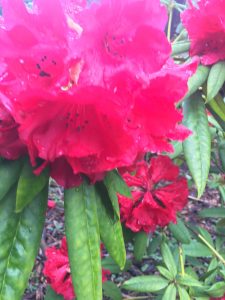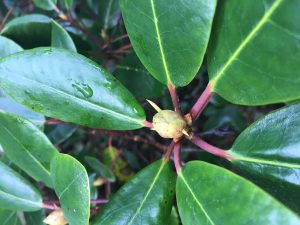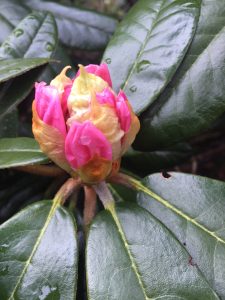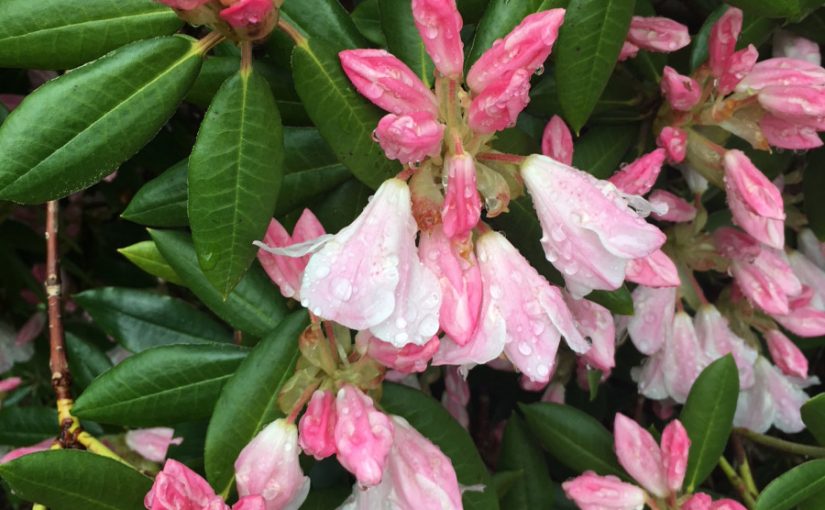Family: Ericaceae (also in this family: heather, heath, blueberry, cranberry, huckleberry, salal, azalea) This is the 14th most diverse family, including a wide range of flora morphologically speaking such as herbs, dwarf shrubs, shrubs, and trees (Bayton & Maughan).
Subfamily: Ericoideae
Tribe: Rhodoreae
Genus: Rhododendron
Scientific Name: Rhododendron macrophyllum

Photo: Allie Kuppenbender
With in the genus Rhododendron, there are over 1000 species ranging “from prostrate ground covers growing no more than a few inches high to trees more than 100 feet tall. Leaf sizes range from less than 1/4 inch to over three feet long, and they also appear in a variety of shapes:rounded, lance-shaped, and elliptical. The flowers may be white, red, pink, yellow, approximate blue, purple, magenta, orange, and shades and mixtures of most of these colors. There is diversity, too, in bark texture and color. And while March, April, and May represent the peak months for flowering, some rhododendrons can flower as early as January in an ideal climate and others as late as August. The actual beauty of many is supreme–in flower, in decorative new growth, in foliage, in bark, in structure, and even in fall color, particularly with deciduous azaleas” (Rhododendron Species Botanical Garden).
Pacific Rhododendrons (Rhododendron macrophyllum) are native to the Pacific Northwest, namely along the northern California coast through the Oregon coast (but mainly south of the Siuslaw River) and around the Salish Sea in Washington and British Columbia, Canada. They are mainly west of the Cascades and east of the Olympic Mountains, but there have been some documented anomalies to that range. They are generally found in disturbed areas, either road embankments or recently deforested wetlands. They can also live in higher elevations in the Olympic and Cascade Mountains. Their leaves are evergreen; they retain them for 2-3 years. They are generally 3–9 in long and 1–3 in broad. Their flowers are generally a pale to more vibrant pink color and are made up of a five-lobed corolla.

Photo: Allie Kuppenbender
According to the Washington Native Plant Society:
- Zone: 8-9
- Bloom Time: May, June, July
- Bloom Size: 1.1–1.6 in
- Height: Up to 7–30 ft
- Soil: moist to dry and acidic soil
- Site: partial shade to full sun, well-draining soil of average moisture, prefers disturbed sites
- Type: Woody
- Seed Type: Dicotyledon

Photo: Allie Kuppenbender
According to Diane Szukovathy of Jello Mold Farm, rhododendrons can be a bit tricky as a cut flower. She hasn’t grown them as a field crop and says they can be a bit finicky and may work a lot better in a more permaculture/polyculture setting. If you did want to grow them in the field, they would definitely require shade cloth and a long while to establish. That being said, there is a certain type of florist that would pay top dollar for these woodies, especially an earlier flowering variety as people are dying for color in the early spring. Harvest when the flower just starts to break bud into clean buckets with hydrating solution. Cut an X on the end of the branch to ensure water is circulating.
SOURCES:
Jello Mold Farm (Mount Vernon, WA)
Meerkerk Rhododendron Gardens and Nursery (Whidbey Island, WA)
About Rhododendrons, Rhododendron Species Botanical Garden
Pacific Rhododendron: Rhododendron macrophyllum, Washington Native Plant Society
Pacific Rhododendron: Rhododendron macrophyllum, Native Plants PNW
Guide to Flowering Plant Families, Wendy B. Zomlefer
Plant Families: A Guide for Gardeners and Botanists, Ross Bayton and Simon Maughan
